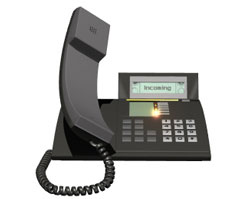By: John Shepler
Every business, regardless of size, requires at least one telephone line. While phone lines may seem straightforward, you might have more choices than you realize. Are you confident that your business has the most suitable phone line?
The traditional analog phone line, known as POTS (Plain Old Telephone Service), is a basic and familiar option.
POTS lines are simple, consisting of a single twisted copper pair connecting a standard RJ-11 phone jack on your wall directly to the telephone company’s central office. A varying electrical current in the wires carries the phone conversation.
It’s worth noting that POTS functions as a self-contained phone system. Traditionally, phones used passive electrical components and drew power directly from the phone line. This feature ensures phone service even during power outages, as long as the phone itself doesn’t require external power.
However, modern phones, even single-line models, often rely on electronic components and need AC power adapters or batteries. This is particularly true for cordless phone systems with multiple handsets. While you might still have a dial tone during a power outage, you’ll need a backup battery for the phone to function.
Multiple Lines
You’re not limited to a single POTS line; you can have as many as you need. Keep in mind that there’s no cost advantage to having multiple lines. Each line has a fixed price, whether you use one phone per line or share external lines using a Key Telephone System or PBX.
Wireless as an Option
Cellular phone service offers the possibility of eliminating landlines entirely. With cell towers replacing wires, wireless communication can be a practical solution for independent professionals who are frequently out of the office. A data plan allows for internet and voice telephony on the same device. You can enhance your mobile setup with features like a toll-free number, fax capability, and international calling. Shared plans can accommodate small offices as well. However, larger operations will likely still require wired landlines.
Moving up to Trunks
A telephone trunk consists of multiple phone lines combined into a single cable. While analog trunks existed in the past, digital technology has become the standard. The most prevalent types of trunks are T1, ISDN PRI, and SIP.
T1 lines were developed to replace multiple analog POTS lines. Instead of separate wires, T1 lines utilize multiplexing to divide the available bandwidth into 24 independent channels, each functioning like a separate phone line.
If you have numerous phones and want to replace individual lines with a single T1 line, you might achieve the same or better service at a lower cost. A “channel bank” converts signals between T1 channels and analog lines, allowing you to connect your phones as usual.
T1 vs ISDN PRI
ISDN PRI (Primary Rate Interface) is a variation of the T1 line that employs the same channelization method but reserves one channel for dialing and switching for the remaining channels. This means you have a maximum of 23 available outside lines on a PRI trunk. However, ISDN PRI offers faster call switching, which is advantageous for call centers and businesses requiring highly efficient phone operations.
Most modern PBX systems have integrated interface circuitry for both T1 and ISDN PRI. You connect the trunk line, and the system manages the necessary conversions.
SIP Trunks
Many companies are transitioning to or considering VoIP technology. SIP trunks are a natural fit for VoIP phone systems because they use the same protocol (SIP). VoIP or SIP phones connect directly to an Ethernet LAN, often shared with computers, printers, and other network devices. The SIP trunk extends this network to connect to the VoIP service provider.
Similar to T1 and ISDN PRI, SIP trunks support multiple simultaneous conversations. However, these conversations utilize packet streams combined on a single line instead of separate channels.
An additional benefit of SIP trunks is their ability to carry both internet data and phone calls using packet format. Prioritizing voice traffic over data traffic within the trunk, known as Class of Service or Quality of Service, ensures optimal voice quality.
To determine the most suitable phone line for your business, a quick approach is to obtain competitive quotes for various options, from POTS to SIP trunking.


